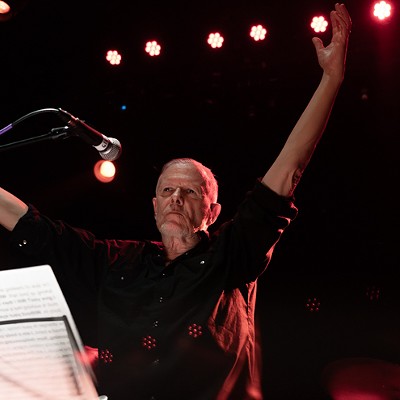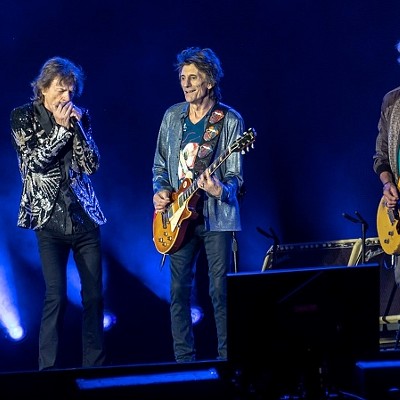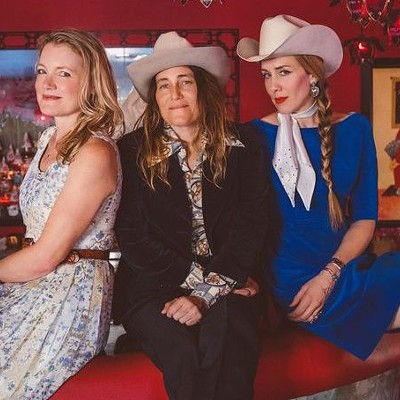But one of his less-shining moments occurred when meeting a group of teenage girls from his own native Liverpool who had started their own band. They were brought into the mop tops’ dressing room at the city’s Cavern Club by DJ Bob Wooler, even though the lads were clad in their skivvies after a sweaty set onstage.
“Girls don’t play guitars,” John Lennon sniffed dismissively.
And while they would have some ‘60s success in Europe, the Liverbirds have been sometimes viewed as just a footnote in Beatle history.
That changes with (among other things) the publication of a memoir written by the two surviving members Mary McGlory and Sylvia Saunders, The Other Fab Four: The Remarkable True Story of the Liverbirds, Britain’s First Female Rock Band (336 pp., $30, Grand Central Publishing).
McGlory and Saunders—Zooming in from Germany and England respectively—have had more than six decades to ponder Lennon’s four words, which only fueled their drive to prove him wrong.
“Well in 1962 it, was rare to see females play guitars,” McGlory says.
“And drums!” Saunders chimes in.
“But there’s obviously a lot more now. It makes us proud to maybe think we started the ball rolling,” McGlory adds. At least they had one Beatle in their corner, with Paul McCartney offering to the girls in that same Cavern dressing room “What a great idea!”
As the rhythm section, McGlory and Saunders grew especially close both onstage and off. It’s something the pair say they’ve heard before.
“We were all friends, all four of us,” Saunders says. “We came from the same background and none of us was richer than the other.”
The Liverbirds name has a double meaning. They are the two 18ft metal sculptures of birds which had been watching over the city and its waterfront port since 1911 atop the Royal Liver Building. “Birds” is also English slang for young girls.
The seeds of the band began in 1962 when McGlory—who had just seen the Beatles at the Cavern Club—went right out with some friends to buy instruments and start their own band.

The Liverbirds in the dressing room at the Star-Club.
Personal collection of Sylvia Saunders/Mary McGlory
And though their early set list was mostly instrumentals and covers ranging from the rock instrumental “Apache” to—believe it or not—the traditional Jewish song “Hava Nagila,” they added more R&B and early rock covers.
They also brushed shoulders with a couple of other giants of British rock. Sharing a bill with the Rolling Stones, McGlory broke a bass string in mid-performance. She was shocked, thinking they were “indestructible.” Stones bassist Bill Wyman lent her his instrument for the rest of the show, then put on a new string afterwards.
The Kinks were also supporters, especially Ray Davies—who seemed to be keen on Gell, though she had eyes for his brother Dave (Birch—the group’s wild child—rubbed more than shoulders with Stones frontman Mick Jagger).
When the Liverbirds were at a Kinks demo recording session, the boys found out their instruments had been stolen. The ‘Birds more than happily loaned the brothers theirs as the Kinks played a new song they’d been working on—“You Really Got Me.”
A less pleasant moment happened when the Liverbirds were opening for Chuck Berry at Hamburg’s Star-Club. After being explicitly told not to play any of Berry’s songs before he went on, Birch cheekily proceeded to do just that, ignoring the shouts and stares of Berry and his manager.
But ol’ Chuck must have seen something he liked, because the next day his manager offered the Liverbirds the chance to fly to Las Vegas in the U.S. to be his backing group with only one catch: They had to play topless. The group declined.
When they jettisoned a bad manager, the girls decided to take a chance and see if the Brian Epstein could do for them what he did for the Beatles. On a whim, they took an 8-hour train ride to London, tracked down Epstein (who at first thought they were crazed Fabs fans), and secured an audition.
He was interested and offered to manage the group. As did Larry Page who did similar duties for the Kinks. But the Liverbirds decided to take a six-month gig at the Star-Club, tapping its Manfred Weissleder to steer the group. They eventually decided to stay with Hamburg as a home base for the remainder of their lifespan.
“Not everyone that Brian Epstein managed was successful. We definitely made the right decision for us. We never regretted it,” McGlory says.
Some of the book’s best parts are when McGlory and Saunders recall the many characters they encountered in the city from barmaids and sex workers to shady characters other bands (including Beatles-footnote acts like the Remo Four and Kingsize Taylor and the Dominoes). Somehow, it all sounds fun and exciting and like a community.
“One of the first questions we ever got asked was how we reacted to the pimps and the prostitutes and their bodyguards. It was meant to be, like a jigsaw!” McGlory laughs.
“We didn’t think anything of it to be honest. We were all young. I was 17 and the other girls were 18. When we saw Hamburg it was like ‘Gosh, this is fantastic!’” Saunders adds. “You saw all the sex places. It’s where we really grew up!”
The Beatles connection would continue: The Liverbirds had Astrid Kircherr, former girlfriend of original Beatles bassist Stu Sutcliffe, as a fashion consultant. McGlory recounts losing her virginity to band friend Klaus Voorman, who would go on to design the cover for Revolver and later play with Lennon's Plastic Ono Band.
And while McGlory was had only fleeting experience with marijuana, word got around town about her abilities in another area. So much that when Jimi Hendrix played the Star-Club in 1967, he asked for her by name.
“I heard you make the best joints in Hamburg,” the guitarist said. McGlory, taking out a bag, obliged with her handiwork.
The Liverbirds would appear on two albums and prove a popular concert draw around Europe, appealing to both boys and girls with their music. Though it was admittedly frozen in the Bo Diddley-style beat.
“We didn’t want to go psychedelic and change with the times,” McGlory says. And that’s help us to keep that ‘60s sound today.” [Note: There are several videos on YouTube of the Liverbirds performing live on Germany's Beat Club TV show, but they are not playable on other websites].
Yes, the Liverbirds actually have a new record out, Diddley Daddy. McGlory and Saunders (both now in their late ‘70s) are joined by younger musicians Molly Grace Cutler and Liz Wright standing in for Gell and Birch.
When Saunders and Gell had to leave the group for family obligations, two replacements were found for a hugely successful Japanese tour. But it was the swan song for the Liverbirds, and they folded in 1968.
The rest of The Other Fab Four follows the women over the ensuing decades as their lives intertwine, take different paths, and find time for the occasional reunion gig.
Shockingly, 2024 seems to be the busiest time ever for the Liverbirds. In addition to The Other Fab Four, the release of Diddley Daddy and a revival this fall of the recent UK musical about them (titled—of course—Girls Don’t Play Guitars), there is now a feature film in the works, back on track after COVID and the Writer’s Strike.
In terms of the book, each member wrote their chapters separately. And Saunders was shocked herself to find the detail of the tragedies and risky lifestyles that Gell and Birch had. Also surprised were their own descendants.
“Our children and grandchildren are really amazed!” McGlory laughs. In fact, it’s inspired Saunders’ now 32-year-old son, a former musician, to pick up his guitar again. He even wrote two songs for Diddley Daddy.
Still, with all this Liverbirds activity, one burning question remains. Can Mary McGlory still twist an amazing joint?
Both McGlory and Saunders erupt in laughter at the question.
“If you bring us over, Mary will roll one for you!” Saunders says. When I mention that it should be sizable-sized doobie since Everything is Bigger in Texas, McGlory is quick to put me in place.
“I’ll do my best, Bob,” she says wryly. “But if it was good enough for Jimi Hendrix, it should be good enough for you!”









